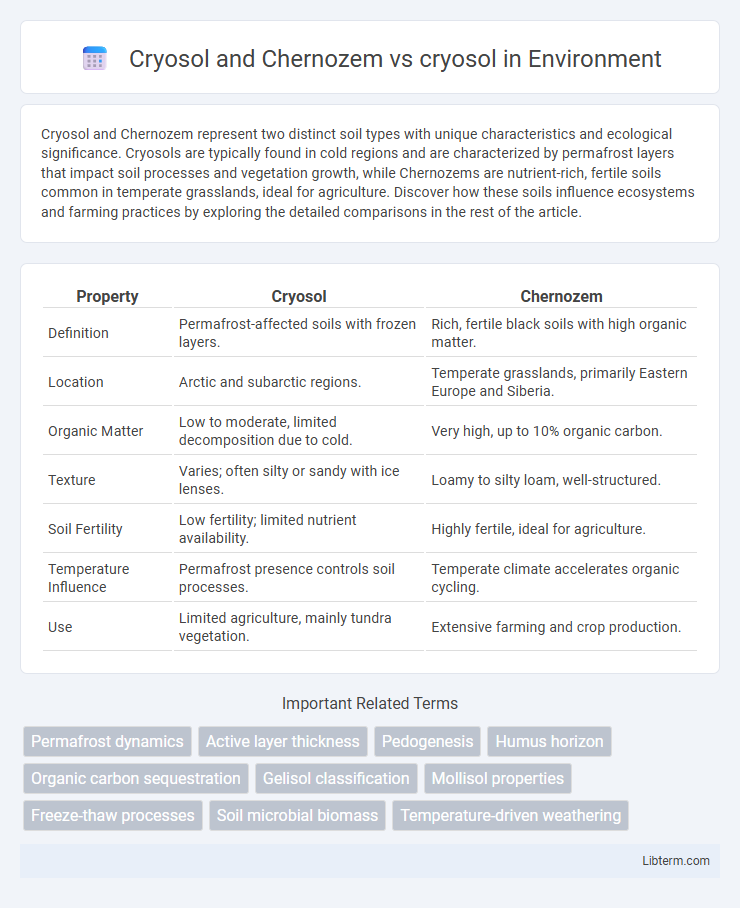Cryosol and Chernozem represent two distinct soil types with unique characteristics and ecological significance. Cryosols are typically found in cold regions and are characterized by permafrost layers that impact soil processes and vegetation growth, while Chernozems are nutrient-rich, fertile soils common in temperate grasslands, ideal for agriculture. Discover how these soils influence ecosystems and farming practices by exploring the detailed comparisons in the rest of the article.
Table of Comparison
| Property | Cryosol | Chernozem |
|---|---|---|
| Definition | Permafrost-affected soils with frozen layers. | Rich, fertile black soils with high organic matter. |
| Location | Arctic and subarctic regions. | Temperate grasslands, primarily Eastern Europe and Siberia. |
| Organic Matter | Low to moderate, limited decomposition due to cold. | Very high, up to 10% organic carbon. |
| Texture | Varies; often silty or sandy with ice lenses. | Loamy to silty loam, well-structured. |
| Soil Fertility | Low fertility; limited nutrient availability. | Highly fertile, ideal for agriculture. |
| Temperature Influence | Permafrost presence controls soil processes. | Temperate climate accelerates organic cycling. |
| Use | Limited agriculture, mainly tundra vegetation. | Extensive farming and crop production. |
Understanding Cryosols: Definition and Key Features
Cryosols are soils found in cold regions, characterized by permafrost within two meters of the surface, restricting root growth and microbial activity. Chernozem soils, in contrast, are fertile, dark-colored soils rich in organic matter, typically found in temperate grasslands without permafrost influence. Understanding Cryosols involves recognizing their unique thermal regimes, limited nutrient cycling, and their crucial role in carbon storage within Arctic and subarctic ecosystems.
Introduction to Chernozem: Characteristics and Importance
Chernozem is a fertile black soil rich in organic matter and nutrients, primarily found in temperate grassland regions such as the Russian steppes and Canadian prairies. Its high humus content and excellent moisture retention make it ideal for agriculture, supporting crops like wheat and barley. In contrast, Cryosol develops in cold climates with permafrost and has limited agricultural use due to frozen ground conditions affecting root growth and soil microbial activity.
Cryosol vs. Chernozem: Fundamental Differences
Cryosols develop in cold regions with permafrost, characterized by frozen soil layers that affect organic matter decomposition and nutrient availability. Chernozems form in temperate grasslands with thick, dark, humus-rich topsoil, supporting high agricultural productivity due to their nutrient-rich composition. The fundamental difference lies in Cryosol's adaptation to permafrost and cold climates versus Chernozem's development in warm, stable soils with high biological activity.
Geographic Distribution of Cryosols and Chernozems
Cryosols predominantly occur in high-latitude regions, such as Siberia, northern Canada, and Alaska, where permafrost influences soil formation. Chernozems are mainly found in temperate grassland areas, notably the Eurasian Steppe and the North American Great Plains, characterized by deep, rich organic matter. The geographic distribution of cryosols and chernozems reflects their distinct climatic and environmental conditions, with cryosols linked to cold, frozen landscapes and chernozems to fertile, temperate grasslands.
Soil Formation Processes: Cryosol and Chernozem Compared
Cryosol soils form primarily through freeze-thaw cycles, leading to permafrost presence and limited organic matter decomposition, while Chernozem develops under grassland vegetation with intense biological activity and humus accumulation. Pedogenic processes in Cryosols include cryoturbation and gelifluction, creating patterned ground features, whereas Chernozems result from prolonged carbon input and mineral weathering enhancing soil fertility. The contrast in soil formation reflects climatic influence, with Cryosols in cold, permafrost regions and Chernozems thriving in temperate, semi-arid steppe environments.
Physical and Chemical Properties: Cryosol vs Chernozem
Cryosols are characterized by permafrost presence and typically have low soil temperatures, which limit organic matter decomposition and result in low nutrient availability, high soil moisture, and often acidic pH. Chernozems, on the other hand, are fertile soils rich in humus, with high organic carbon content, neutral to slightly alkaline pH, and excellent structure that promotes water retention and aeration. Physically, Cryosols tend to have poorly developed horizons and ice-rich layers, while Chernozems exhibit well-defined dark topsoil horizons with granular structure ideal for agriculture.
Agricultural Potential: Chernozem vs. Cryosol
Chernozem soils possess exceptional agricultural potential due to their high organic matter content and excellent nutrient availability, making them ideal for growing cereals and other crops. In contrast, Cryosol soils, typically found in cold regions with permafrost, have limited agricultural value because of their poor drainage, low temperatures, and restricted nutrient cycling. The superior fertility and favorable structure of Chernozem significantly surpass the constraints of Cryosol for sustainable farming productivity.
Environmental Significance of Cryosols and Chernozems
Cryosols store vast amounts of organic carbon in permafrost, playing a crucial role in the global carbon cycle and climate regulation, especially in polar and subpolar regions. Chernozems, rich in humus and nutrients, support highly productive agricultural systems, significantly influencing food security and soil health in temperate grasslands. The environmental significance of cryosols lies in their vulnerability to thawing-induced greenhouse gas release, while chernozems are vital for sustaining biodiversity and preventing soil erosion in fertile ecosystems.
Climate Influence on Cryosol and Chernozem Development
Cryosols develop primarily in cold climates with permafrost, where low temperatures limit organic matter decomposition, creating frozen soils rich in partially decomposed organic materials. Chernozems form in temperate grassland regions with moderate to low precipitation, promoting high organic matter accumulation and fertile topsoils due to seasonal temperature variations that enhance microbial activity. Climate directly influences Cryosol formation through continuous freezing, while Chernozem development thrives under warmer temperatures and periodic moisture availability, dictating soil structure and nutrient content.
Sustainable Management Practices: Cryosol and Chernozem
Sustainable management practices for Cryosol emphasize minimizing soil disturbance and preserving permafrost integrity to prevent carbon release and maintain soil structure. Chernozem soils, rich in organic matter and nutrients, benefit from crop rotation, conservation tillage, and optimized fertilization to enhance soil fertility and prevent erosion. Both soil types require tailored approaches to sustain productivity while mitigating environmental impacts linked to climate change and land use.
Cryosol and Chernozem Infographic

 libterm.com
libterm.com